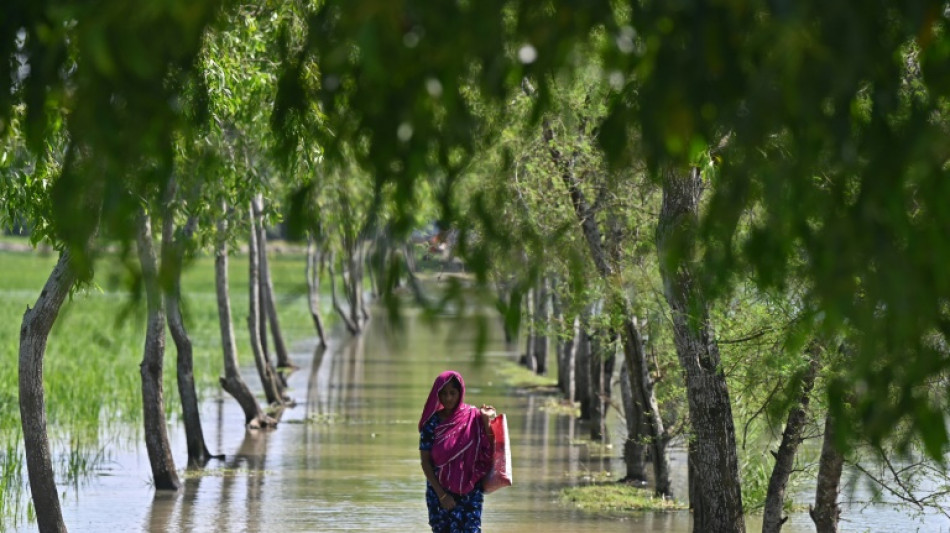
-
 Rome's Trevi Fountain reopens to limited crowds
Rome's Trevi Fountain reopens to limited crowds
-
Mbappe strikes as Real Madrid down Sevilla

-
 Pope again condemns 'cruelty' of Israeli strikes on Gaza
Pope again condemns 'cruelty' of Israeli strikes on Gaza
-
Lonely this Christmas: Vendee skippers in low-key celebrations on high seas

-
 Troubled Man Utd humiliated by Bournemouth
Troubled Man Utd humiliated by Bournemouth
-
2 US pilots shot down over Red Sea in 'friendly fire' incident: military

-
 Man Utd embarrassed by Bournemouth, Chelsea held at Everton
Man Utd embarrassed by Bournemouth, Chelsea held at Everton
-
France awaits fourth government of the year

-
 Death toll in Brazil bus crash rises to 41
Death toll in Brazil bus crash rises to 41
-
Odermatt stays hot to break Swiss World Cup wins record

-
 Neville says Rashford's career at Man Utd nearing 'inevitable ending'
Neville says Rashford's career at Man Utd nearing 'inevitable ending'
-
Syria's new leader vows not to negatively interfere in Lebanon

-
 Germany pledges security inquest after Christmas market attack
Germany pledges security inquest after Christmas market attack
-
Putin vows 'destruction' on Ukraine after Kazan drone attack

-
 Understated Usyk seeks recognition among boxing legends
Understated Usyk seeks recognition among boxing legends
-
France awaits appointment of new government

-
 Cyclone Chido death toll rises to 94 in Mozambique
Cyclone Chido death toll rises to 94 in Mozambique
-
Stokes out of England's Champions Trophy squad

-
 Gaza rescuers say Israeli strikes kill 28
Gaza rescuers say Israeli strikes kill 28
-
Sweet smell of success for niche perfumes

-
 'Finally, we made it!': Ho Chi Minh City celebrates first metro
'Finally, we made it!': Ho Chi Minh City celebrates first metro
-
Angry questions in Germany after Christmas market attack

-
 China's Zheng pulls out of season-opening United Cup
China's Zheng pulls out of season-opening United Cup
-
Minorities fear targeted attacks in post-revolution Bangladesh

-
 Tatum's 43-point triple-double propels Celtics over Bulls
Tatum's 43-point triple-double propels Celtics over Bulls
-
Tunisia women herb harvesters struggle with drought and heat

-
 Trump threatens to take back control of Panama Canal
Trump threatens to take back control of Panama Canal
-
India's architecture fans guard Mumbai's Art Deco past

-
 Secretive game developer codes hit 'Balatro' in Canadian prairie province
Secretive game developer codes hit 'Balatro' in Canadian prairie province
-
Large earthquake hits battered Vanuatu

-
 Beaten Fury says Usyk got 'Christmas gift' from judges
Beaten Fury says Usyk got 'Christmas gift' from judges
-
First Singaporean golfer at Masters hopes 'not be in awe' of heroes

-
 Usyk beats Fury in heavyweight championship rematch
Usyk beats Fury in heavyweight championship rematch
-
Stellantis backtracks on plan to lay off 1,100 at US Jeep plant

-
 Atletico snatch late win at Barca to top La Liga
Atletico snatch late win at Barca to top La Liga
-
Australian teen Konstas ready for Indian pace challenge

-
 Strong quake strikes off battered Vanuatu
Strong quake strikes off battered Vanuatu
-
Tiger Woods and son Charlie share halfway lead in family event

-
 Bath stay out in front in Premiership as Bristol secure record win
Bath stay out in front in Premiership as Bristol secure record win
-
Mahomes shines as NFL-best Chiefs beat Texans to reach 14-1

-
 Suspect in deadly Christmas market attack railed against Islam, Germany
Suspect in deadly Christmas market attack railed against Islam, Germany
-
MLB legend Henderson, career stolen base leader, dead at 65

-
 Albania announces shutdown of TikTok for at least a year
Albania announces shutdown of TikTok for at least a year
-
Laboured Napoli take top spot in Serie A

-
 Schick hits four as Leverkusen close gap to Bayern on sombre weekend
Schick hits four as Leverkusen close gap to Bayern on sombre weekend
-
Calls for more safety measures after Croatia school stabbings

-
 Jesus double lifts Christmas spirits for five-star Arsenal
Jesus double lifts Christmas spirits for five-star Arsenal
-
Frankfurt miss chance to close on Bayern as attack victims remembered

-
 NBA fines Celtics coach Mazzulla and Nets center Claxton
NBA fines Celtics coach Mazzulla and Nets center Claxton
-
Banned Russian skater Valieva stars at Moscow ice gala


16 dead, million seek shelter as Cyclone Sitrang hits Bangladesh
At least 16 people died after Cyclone Sitrang slammed into Bangladesh, forcing the evacuation of about a million people from their homes, officials said Tuesday.
Cyclones -- the equivalent of hurricanes in the Atlantic or typhoons in the Pacific -- are a regular menace but scientists say climate change is likely making them more intense and frequent.
Sitrang made landfall in southern Bangladesh late Monday but authorities managed to get about a million people to safety before the monster weather system hit.
Around 10 million people were without power in districts along the coast on Tuesday, while schools were shut across much of the country's south.
Government official Jebun Nahar said 16 people died, mostly after they were hit by falling trees, with two killed when their boat sank in squally weather in the Jamuna River in the north.
"We still have not got all the reports of damages," she told AFP.
Eight people are missing from a dredging boat that sank during the storm late Monday night in the Bay of Bengal, near the country's largest industrial park at Mirsarai, regional fire department chief Abdullah Pasha said.
"Strong wind flipped the dredger and it sank instantly in the Bay of Bengal," he told AFP, adding that divers were searching for survivors.
People evacuated from low-lying regions such as remote islands and river banks were moved to thousands of multi-storey cyclone shelters, Disaster Management Ministry secretary Kamrul Ahsan told AFP.
"They spent the night in cyclone shelters. And this morning many are heading back to their homes," he said.
Ahsan said nearly 10,000 homes were either "destroyed or damaged" in the storm and around 1,000 shrimp farms had been washed away in floods.
In some cases police had to cajole villagers who were reluctant to abandon their homes, officials said.
Trees were uprooted as far away as the capital Dhaka, hundreds of kilometres from the storm's centre.
Heavy rains lashed much of the country, flooding cities such as Dhaka, Khulna and Barisal -- which took on 324 millimetres (13 inches) of rainfall on Monday.
About 33,000 Rohingya refugees from Myanmar, controversially relocated from the mainland to a storm-prone island in the Bay of Bengal, were ordered to stay indoors but there were no reports of casualties or damage, officials said.
- Panic and snakes -
The cyclone uprooted trees and brought widespread panic to the southern island of Maheshkhali after power and telecoms were cut.
"Such was the power of the wind we could not sleep in the night because of the fear that our homes will be destroyed. Snakes entered many homes. Water also inundated many homes," said Tahmidul Islam, 25, a resident of Maheshkhali.
In the worst-affected Barisal region, teeming rains and heavy winds wreaked havoc on vegetable farms, district administrator Aminul Ahsan told AFP.
In the neighbouring Indian state of West Bengal, thousands of people were evacuated Monday to more than 100 relief centres, officials said, but there were no reports of damage and people were returning home on Tuesday.
Last year, more than a million people were evacuated along India's east coast before Cyclone Yaas battered the area with winds gusting up to 155 kilometres (96 miles) an hour -- equivalent to a Category 2 hurricane.
Cyclone Amphan, the second "super cyclone" recorded over the Bay of Bengal, killed more than 100 people in Bangladesh and India and affected millions when it hit in 2020.
In recent years, better forecasting and more effective evacuation planning have dramatically reduced the death toll from such storms. The worst recorded, in 1970, killed hundreds of thousands of people.
Ferreira--PC




